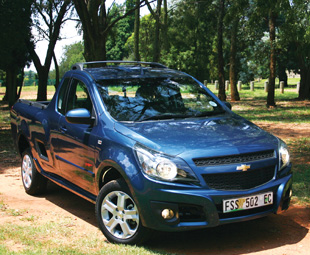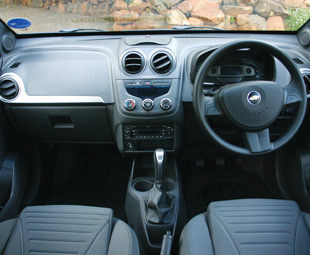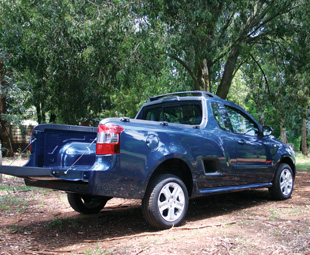The aliens have landed

Don’t panic, but the aliens are taking over! GAVIN MYERS got up close and personal with one – not to try and fight it off, but to find out why these newcomers are suddenly everywhere.
The local half-tonne bakkie segment isn’t characterised by frequent change. The major players are those that have been around for decades, with many generations of the same product being released over the years.
General Motors is no exception. Since the mid-1990s, the Opel Corsa Utility – or the Corsa bakkie, as it’s more often called – has undoubtedly been one of South Africa’s favourite half-tonners. In 2004, when the second-generation model was introduced to our market, this vehicle really took the fight to the established players in the segment, especially Ford with its Bantam bakkie.
A few years later, Nissan retired its stalwart 1400 bakkie after 37 years and replaced it with the NP200 – a perennial high-volume seller. With these three vehicles, the LCV arena was to see one of the most hotly contested brand, marketing and sales fights ever. But now that the Bantam is no more, it’s a two-way fight between the NP200 and General Motors’ replacement for the Corsa bakkie – the Chevrolet Utility.
Unfortunately, Nissan has been unable to supply us with an NP200 for evaluation as yet – so alas, this is not the head-to-head we wanted it to be. I will therefore refrain from pitting the two against each other, save to say that as far as sales figures go, this certainly is a two-way battle royale – the rivals posting almost identical numbers during April.
 But what of the Chev Utility? It has consistently racked up sales of almost 4 000 units a month in Brazil, where it was first launched and is known as the Chevrolet Montana, and sold an impressive 1 700 units in SA in March. Why has it been such an instant success – especially with those “from another planet” looks?
But what of the Chev Utility? It has consistently racked up sales of almost 4 000 units a month in Brazil, where it was first launched and is known as the Chevrolet Montana, and sold an impressive 1 700 units in SA in March. Why has it been such an instant success – especially with those “from another planet” looks?
Ah, those looks. On first acquaintance, this bakkie is as odd to behold as one of Men In Black’s finest. Chevrolet might have taken a risk giving its successor to the handsome vehicle that came before it some rather oddball looks, but the big Chevrolet corporate grille and gawky “eyes” do grow on you – and with the right lick of paint, it all actually looks quite good. Top-spec “Sport” models like our 1,4 Sport have colour-coded bumpers and mirrors as well as a roof-mounted spoiler and good-looking 15-inch alloys.
Sport models also come with a decent amount of kit. Convenience features such as air-conditioning and driver and passenger airbags are all in place, as are electric windows and central locking with alarm/immobiliser. The latter work together to deliver some nifty safety features such as the automatic locking of doors at 15 km/h and the automatic closing of windows when the vehicle is locked.
Also fitted are an on-board computer and an excellent six-speaker MP3 sound system that includes both auxiliary input and USB ports. It also has easy-to-use Bluetooth connectivity that allows one to link a phone for both hands-free voice calling and audio-streaming.
While inside the vehicle, it’s nice to note that Chevrolet has taken a fresh approach to the interior. The oblong instrument cluster is different at first but actually easy to read and intuitive, while the rest of the interior is wonderfully ergonomic with scratch-resistant plastics. There is also a plethora of storage spaces in the cabin. While the seats are flat, they are rather comfortable and achieving an easy driving position is no task.
 To drive, however, the little Chev bakkie offers a mixed bag. The 68 kW, 120 Nm 1,4-litre eight-valve petrol engine is certainly underpowered, especially with the air-con running on a hot Joburg summer’s day. The gearbox was also notchy and I missed third gear more often than I’d like to admit (this seemed to be unique to this particular vehicle and is not necessarily a trait of the entire range). The vehicle does have very good chassis control though, being responsive to driver input and gripping well in the dry – it could even be called entertaining. During a Highveld thunderstorm, however, it did show a worrying tendency to aquaplane on the very wet roads – not so entertaining. The brakes are sharp and powerful, aided by ABS and electronic brake-force distribution.
To drive, however, the little Chev bakkie offers a mixed bag. The 68 kW, 120 Nm 1,4-litre eight-valve petrol engine is certainly underpowered, especially with the air-con running on a hot Joburg summer’s day. The gearbox was also notchy and I missed third gear more often than I’d like to admit (this seemed to be unique to this particular vehicle and is not necessarily a trait of the entire range). The vehicle does have very good chassis control though, being responsive to driver input and gripping well in the dry – it could even be called entertaining. During a Highveld thunderstorm, however, it did show a worrying tendency to aquaplane on the very wet roads – not so entertaining. The brakes are sharp and powerful, aided by ABS and electronic brake-force distribution.
Fuel consumption is on the heavy side for such a small motor, mainly due to the fact that large throttle openings are needed in most driving situations. Chevrolet claims combined fuel consumption at 7,2l/100 km, but we couldn’t match that over the test period. One must keep this in mind if planning to have a full 730 kg payload in tow.
The range is covered by a five-year/120 000 km warranty with roadside assistance for the full warranty period, and a corrosion warranty for five years. The 1,4 Sport is priced at R163 000.
In conclusion, then, you might be forgiven for thinking the new Chevrolet Utility is a bit of a mixed bag that may fail to please. But don’t get the wrong idea – after having lived with the vehicle for a week, I have to be honest, I really do like this little bakkie. The 1,8-litre engine might be the better choice up here in the Highveld, but we’ll find that out in a few weeks’ time when, hopefully, we can finally pit it against the Nissan.
Watch this space – I have a sneaky suspicion the aliens might just start ruling our local half-tonne world.
Published by
Focus on Transport
focusmagsa



 Big news from FOCUS on Transport + Logist
Big news from FOCUS on Transport + Logist


 !
Starting 1 April, every
!
Starting 1 April, every


 FUSO: Driving the Future of Mobile Healthc
FUSO: Driving the Future of Mobile Healthc



 A brand
A brand




 Wondering about the maximum legal load for a
Wondering about the maximum legal load for a 
 The MAN hTGX powered by a hydrogen combus
The MAN hTGX powered by a hydrogen combus

 Exciting News for South African Operators
Exciting News for South African Operators


